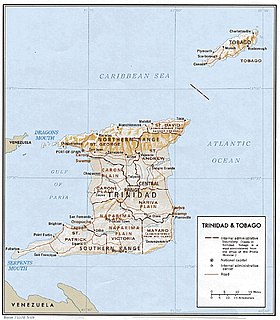Related Research Articles

The Northern Range is the range of tall hills across north Trinidad, the major island in the Republic of Trinidad and Tobago. The hills range from the Chaguaramas peninsula on the west coast to Toco in the east. The Northern Range covers approximately twenty-five percent of the land area of Trinidad.

El Cerro del Aripo, at 940 metres (3,084 ft), is the highest point in the Republic of Trinidad and Tobago. It is part of the Aripo Massif and is located in the Northern Range on the island of Trinidad, northeast of the town of Arima.
Leptophis stimsoni, commonly known as the grey lora or the Trinidad upland parrot snake, is a small species of snake in the family Colubridae. The species is endemic to the Republic of Trinidad and Tobago.
Crusoe Cave is a sea cave on Crown Point, on the island of Tobago in Trinidad and Tobago. The cave is named for the titular main character of the 1719 novel Robinson Crusoe by English writer Daniel Defoe. In the novel, Crusoe is shipwrecked on an unnamed island described as within sight of Trinidad; it is believed by some that Crusoe's island was based on Tobago. The cave has been referred to by this name as early as 1890.
References
- ↑ Whitney, W. D. (1889). "Cave, n.1." def. 1. The Century dictionary: An encyclopedic lexicon of the English language (Vol. 1, p. 871). New York: The Century Co.
- ↑ "Cave" Oxford English Dictionary Second Edition on CD-ROM (v. 4.0) © Oxford University Press 2009
- ↑ Moratto, Michael J. (2014). California Archaeology. Academic Press. p. 304. ISBN 9781483277356.
- ↑ Lowe, J. John; Walker, Michael J. C. (2014). Reconstructing Quaternary Environments. Routledge. pp. 141–42. ISBN 9781317753711.
- ↑ "Aripo Main Cave, Trinidad". Wondermondo.
- ↑ "Aripo Cave". wecaribbean.net. Archived from the original on 2013-01-04. Retrieved 2013-04-15.CS1 maint: unfit URL (link)
- ↑ Ottley, Carlton Robert (1969). Tobago: Robinson Crusoe's Island in the West Indies. Printers: P.N.M. Publishing Company.
- ↑ Islands Magazine. January–February 2004.
- 1 2 3 Bissessarsingh, Angelo (2013-10-01). "Top 10 attractions in Tobago". The Guardian. ISSN 0261-3077 . Retrieved 2020-01-21.
- 1 2 De-Light, Dominique; Thomas, Polly (2001). The Rough Guide to Trinidad and Tobago. Rough Guides. ISBN 978-1-85828-747-8.
- ↑ United States Consular Reports: Reports from the Consuls of the United States on the Commerce, Manufactures, Etc., of Their Consular Districts. U.S. Government Printing Office. 1890.
- ↑ Bulletin of the Maryland Herpetological Society. Maryland Herpetological Society, Department of Herpetology, Natural History Society of Maryland. 1982.
- ↑ Society (U.S.), National Geographic (1980). Research Reports - National Geographic Society. National Geographic Society. ISBN 978-0-87044-608-5.
- ↑ O'Donnell, Kathleen (March 2001). Adventure Guide to Trinidad and Tobago. Hunter Publishing, Inc. ISBN 978-1-58843-257-5.
- ↑ Snow (2008), pp. 137–143.
- ↑ History. William Beebe Tropical Research Station
- ↑ Anne, Hilton (November 12, 2007). "An ecotourism success story". Trinidad and Tobago Newsday . Retrieved 2007-12-05.
- 1 2 3 Kenny, Julian S. (1978–1979). "Floor plan, environment, and fauna of Tamana caves". Living World, Journal of the Trinidad and Tobago Field Naturalists' Club.
- ↑ Day, Michael J.; M. Sean Chenoweth (2004). "The karstlands of Trinidad and Tobago, their land use and conservation". The Geographical Journal. 170 (3): 256–266. doi:10.1111/j.0016-7398.2004.00124.x.

